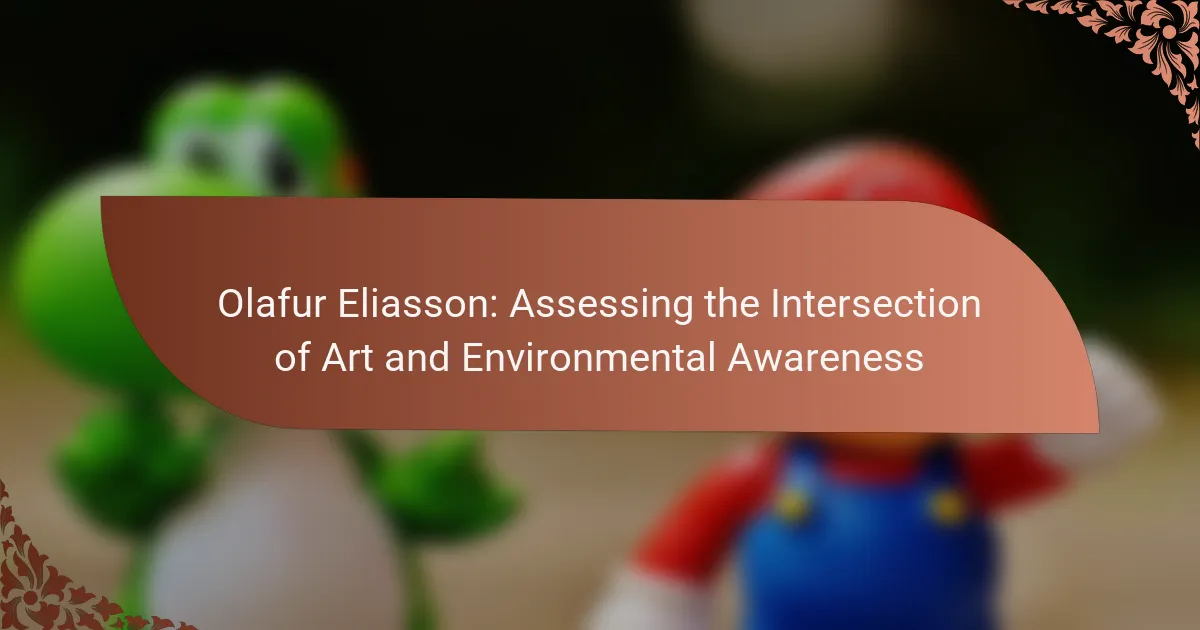Olafur Eliasson’s art serves as a powerful tool for enhancing environmental awareness. His immersive installations, such as “The Weather Project” and “Ice Watch,” engage viewers with pressing climate issues. Eliasson’s unique background and collaboration with scientists deepen the connection between art and ecology. Additionally, his focus on participatory experiences and sustainable practices demonstrates art’s potential to inspire action toward a more sustainable future.
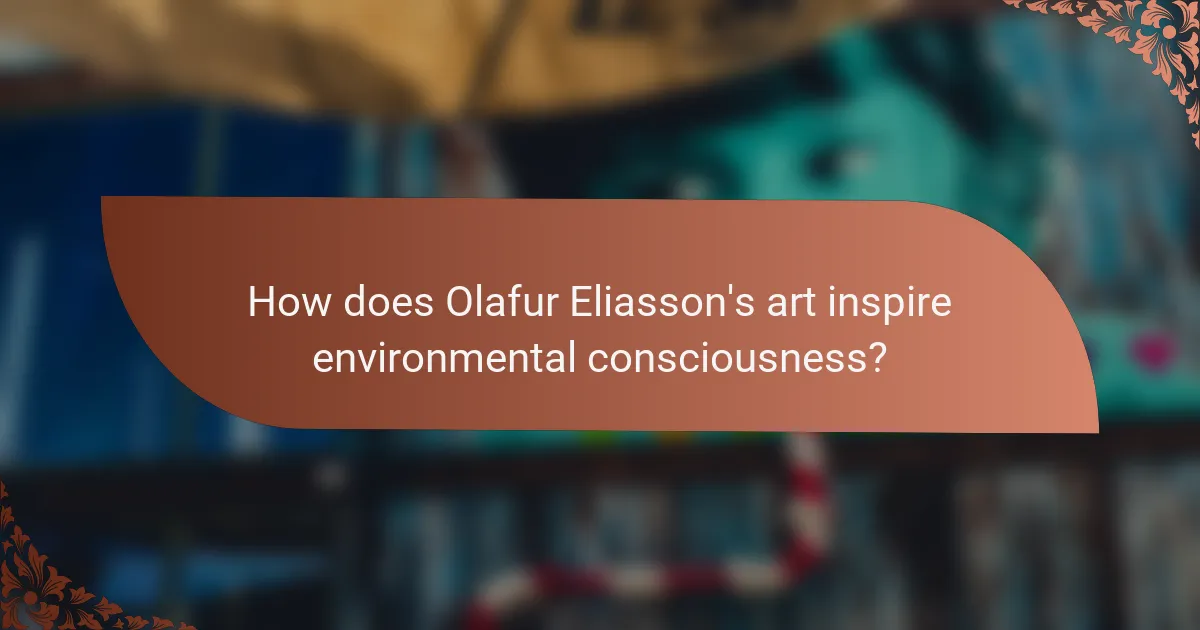
How does Olafur Eliasson’s art inspire environmental consciousness?
Olafur Eliasson’s art inspires environmental consciousness by engaging viewers with immersive experiences that highlight climate issues. His installations often utilize natural elements, prompting reflection on humanity’s relationship with nature. For example, his work “The Weather Project” transformed the Tate Modern, simulating sunlight and encouraging discussions about energy consumption and sustainability. Eliasson’s unique approach combines aesthetics with activism, making environmental themes accessible and emotionally resonant. As a result, his art fosters a deeper awareness of ecological challenges and motivates action toward a more sustainable future.
What themes of nature are prevalent in his work?
Olafur Eliasson frequently explores themes of nature, emphasizing the interconnectedness of humans and the environment. His work often highlights climate change, natural phenomena, and sensory experiences. For example, installations like “The Weather Project” engage viewers with atmospheric conditions, fostering awareness of ecological issues. Additionally, Eliasson’s use of natural light and water reflects his commitment to sustainability and environmental consciousness. His art serves as a catalyst for dialogue on nature’s fragility and humanity’s role in its preservation.
How does Eliasson utilize light and space to convey messages about climate change?
Olafur Eliasson uses light and space to create immersive experiences that provoke thought about climate change. His installations often manipulate natural elements, highlighting environmental issues. For example, “The Weather Project” in the Tate Modern used artificial sunlight to evoke feelings of warmth and community while subtly addressing climate concerns. Eliasson’s work encourages viewers to reflect on their relationship with nature, making them more aware of environmental challenges. By integrating sensory experiences, he fosters emotional connections to climate change, urging action and awareness.

What are the most significant installations by Olafur Eliasson?
Olafur Eliasson has created several significant installations that highlight the connection between art and environmental awareness. Notable works include “The Weather Project,” which transformed the Tate Modern’s Turbine Hall into a simulated sun, promoting reflection on climate change. “Ice Watch” features large blocks of ice placed in urban settings, emphasizing the impact of global warming. “Your Rainbow Panorama” is a circular walkway that offers a colorful perspective of the surroundings, encouraging viewers to appreciate their environment. “Little Sun” is a solar-powered lamp designed to provide light in off-grid areas, merging art with social responsibility. Each installation uniquely addresses ecological themes, fostering awareness and dialogue.
Which works have had the largest public impact?
Olafur Eliasson’s works have significantly impacted public awareness of environmental issues. Notable projects include “The Weather Project,” which highlighted climate change through immersive experiences, and “Ice Watch,” showcasing melting glaciers to evoke urgency. These installations engage audiences, prompting dialogue on sustainability and ecological responsibility. Eliasson’s art uniquely blends aesthetics with activism, making complex environmental themes accessible and compelling.
How do his installations vary in scale and location?
Olafur Eliasson’s installations vary significantly in scale and location, adapting to diverse environments and contexts. His works range from small indoor pieces to large-scale outdoor installations, influencing public spaces globally. Notable examples include “The Weather Project” in London’s Tate Modern and “Ice Watch” in cities like Paris and Copenhagen, highlighting environmental themes. Each installation engages with its surroundings, fostering a unique interaction between art and nature.
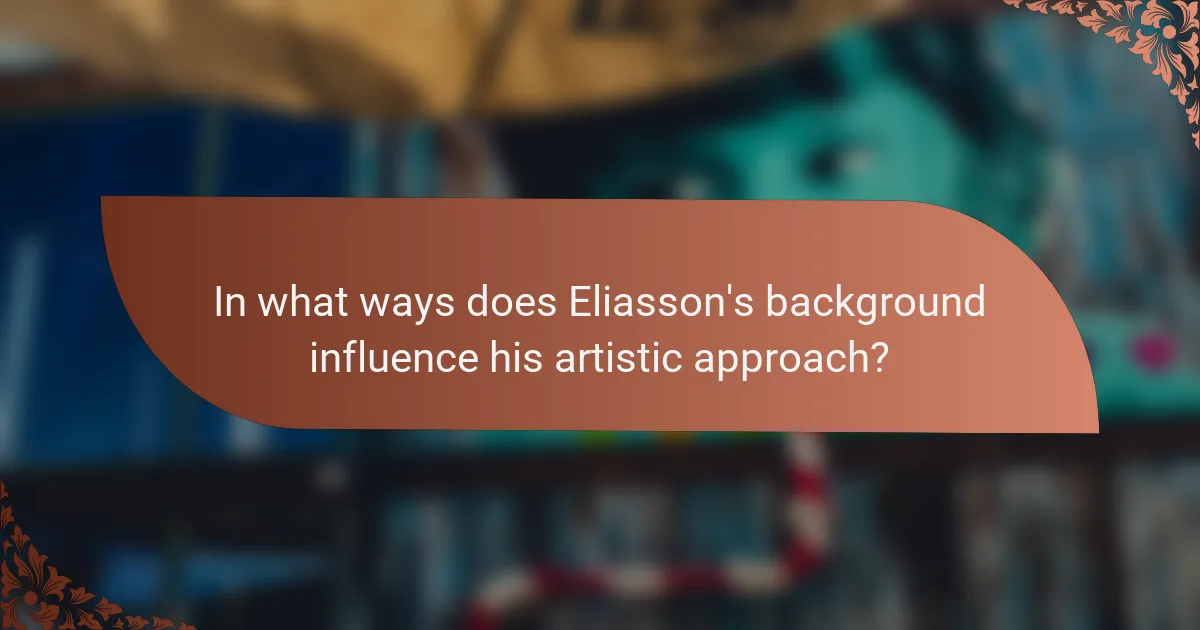
In what ways does Eliasson’s background influence his artistic approach?
Olafur Eliasson’s background significantly shapes his artistic approach by integrating personal experiences with environmental themes. Growing up in Iceland, he developed a profound connection to nature, which informs his use of natural elements in art. His education in architecture and design enhances his understanding of space and perception, allowing him to create immersive installations. Eliasson’s work often emphasizes the relationship between art and climate change, urging viewers to engage with environmental issues. This intersection of personal history and global awareness defines his unique artistic perspective.
How does his upbringing in Iceland shape his perspective on nature?
Olafur Eliasson’s upbringing in Iceland profoundly shapes his perspective on nature, emphasizing its raw beauty and fragility. Growing up in a landscape marked by glaciers and volcanic activity, he developed a deep appreciation for natural phenomena. This environment instilled a sense of responsibility toward environmental awareness, influencing his art to reflect nature’s complexities. His works often invite viewers to engage with natural elements, fostering a connection that encourages ecological consciousness. Eliasson’s experiences in Iceland serve as a unique attribute, distinguishing his artistic vision and commitment to sustainability.
What role does his education play in his exploration of art and science?
Olafur Eliasson’s education profoundly influences his exploration of art and science by integrating scientific principles into artistic practices. His background in architecture and design fosters a unique perspective, allowing him to create immersive installations that engage viewers with environmental themes. Eliasson’s work often incorporates elements of physics and natural phenomena, demonstrating how education shapes his approach to addressing climate change and sustainability through art. This synthesis enhances public awareness and encourages a deeper understanding of the interconnectedness between humanity and the environment.
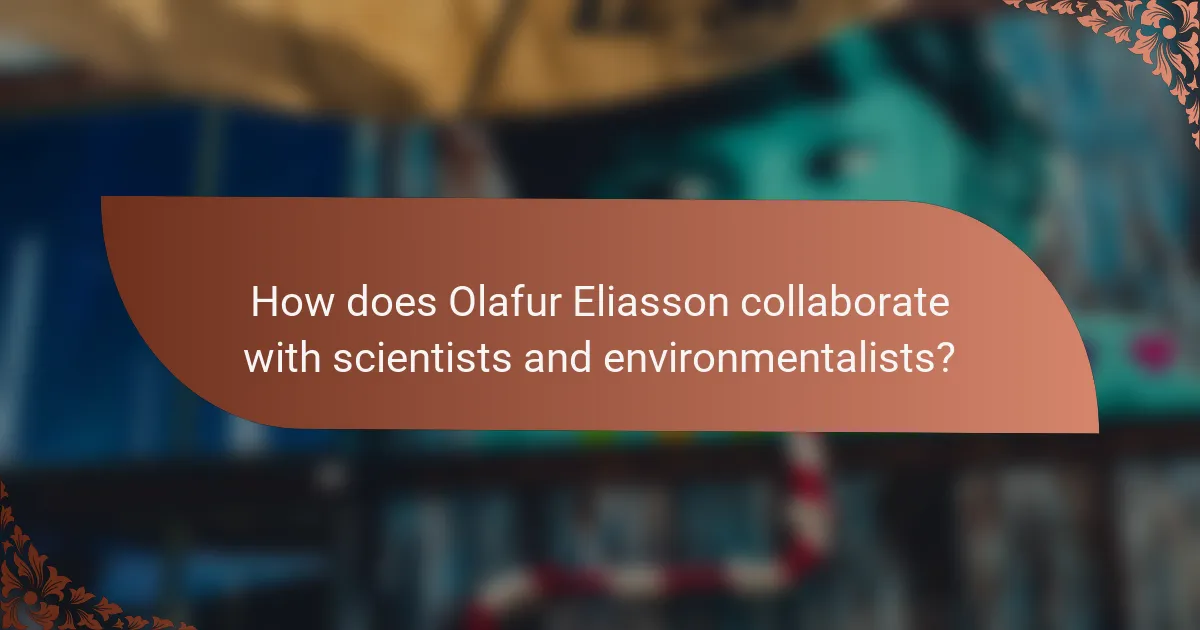
How does Olafur Eliasson collaborate with scientists and environmentalists?
Olafur Eliasson collaborates with scientists and environmentalists to enhance public understanding of climate change. His projects integrate scientific research into artistic experiences, fostering dialogue about environmental issues. For instance, Eliasson’s installation “Ice Watch” involved scientists to highlight glacial melting, bridging art and science effectively. This collaboration emphasizes the urgency of environmental awareness while engaging diverse audiences. Eliasson’s unique approach demonstrates how art can provoke critical discussions on sustainability.
What projects highlight these interdisciplinary partnerships?
Interdisciplinary partnerships in Olafur Eliasson’s projects include collaborations with scientists, architects, and environmental activists. These partnerships enhance the impact of art on environmental awareness. For example, the “Ice Watch” project involved artists and climate scientists to raise awareness about climate change through the melting of ice blocks in urban settings. Another notable collaboration is with the Danish architect Bjarke Ingels, focusing on sustainable urban design. Eliasson’s work often merges aesthetics with ecological education, emphasizing the importance of collective action for environmental sustainability.
How do these collaborations enhance public understanding of environmental issues?
Collaborations enhance public understanding of environmental issues by merging art with critical dialogues. Olafur Eliasson’s projects, for example, use immersive installations to engage audiences emotionally and intellectually. These experiences foster awareness of climate change and sustainability, making complex topics accessible. By transforming abstract concepts into tangible experiences, Eliasson creates a unique platform for discussion and reflection, encouraging collective action.
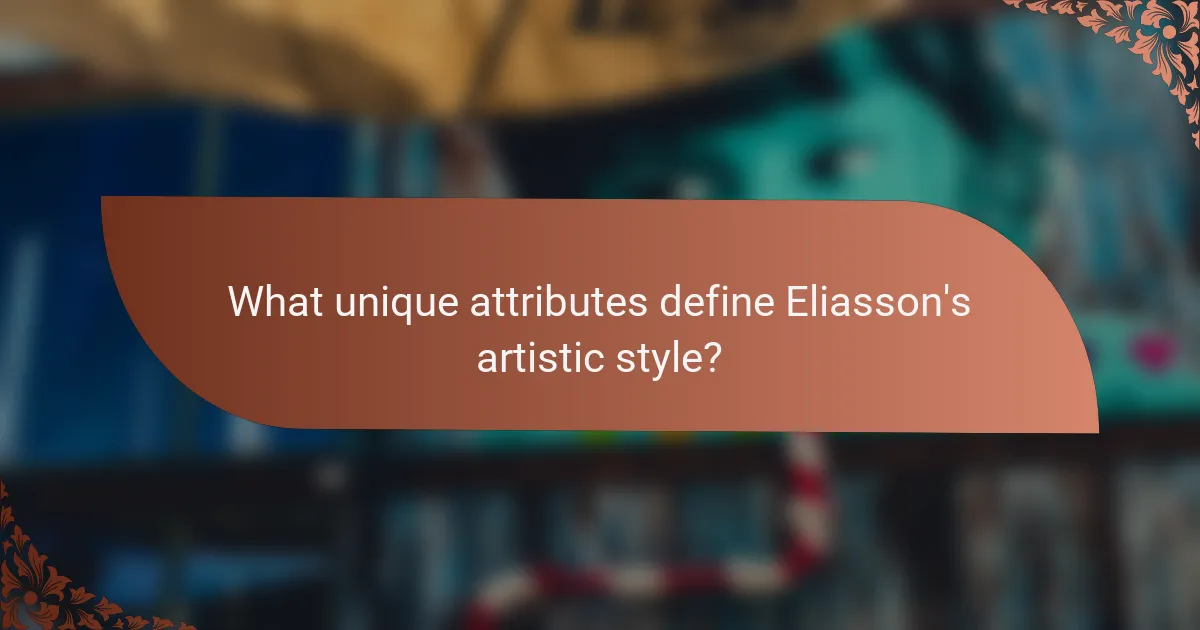
What unique attributes define Eliasson’s artistic style?
Eliasson’s artistic style is defined by immersive experiences, environmental engagement, and innovative use of light. His works often incorporate natural elements, prompting viewers to reflect on their surroundings. Unique attributes include the integration of climate awareness and participatory installations, which invite audience interaction. His approach blends art with science, creating a dialogue around sustainability and perception.
How does he blend art with experiential learning?
Olafur Eliasson blends art with experiential learning by creating immersive installations that engage the senses and provoke environmental awareness. His works, such as “The Weather Project,” invite participants to experience natural phenomena, fostering a deeper connection to the environment. Eliasson emphasizes the importance of perception in understanding climate issues, encouraging viewers to reflect on their relationship with nature. This approach not only enhances artistic appreciation but also cultivates a sense of responsibility toward environmental sustainability.
What role does audience interaction play in his installations?
Audience interaction is central to Olafur Eliasson’s installations, fostering engagement and environmental awareness. His works invite viewers to participate actively, transforming passive observation into a shared experience. This interaction deepens the understanding of climate issues, as participants reflect on their relationship with nature. Eliasson’s unique approach emphasizes the role of collective experience in raising consciousness about environmental challenges.
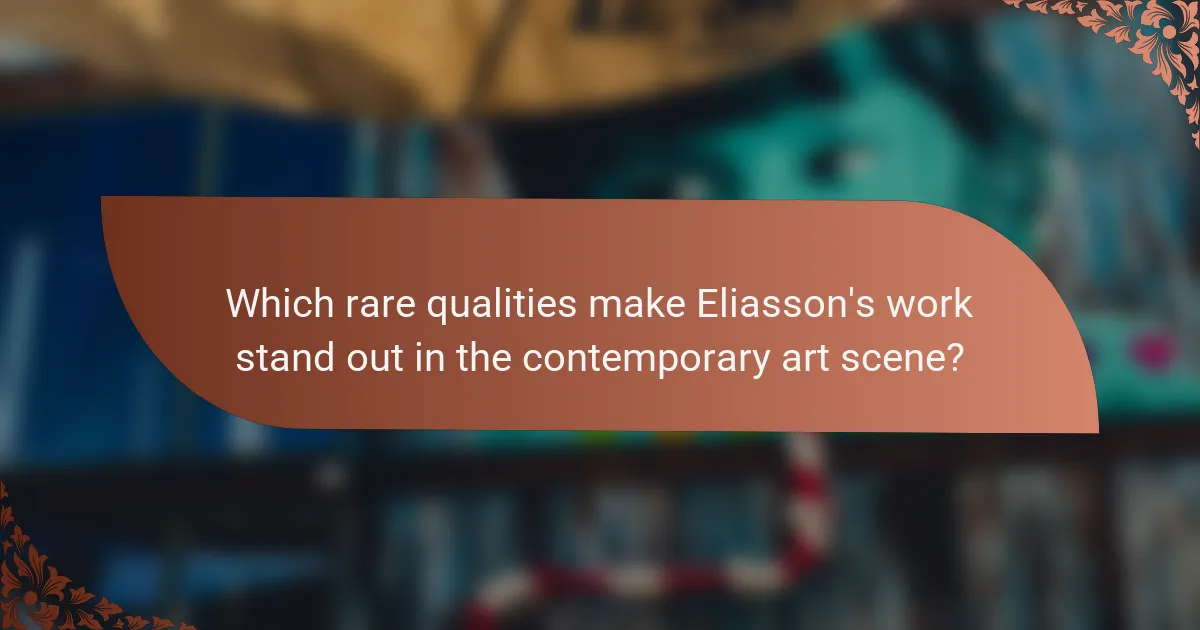
Which rare qualities make Eliasson’s work stand out in the contemporary art scene?
Eliasson’s work stands out due to its unique integration of sensory experiences and environmental themes. His installations often employ light, water, and natural elements, creating immersive spaces that provoke reflection on climate change and human perception. This rare ability to blend art with urgent social issues distinguishes him in contemporary art. Additionally, his focus on participatory experiences invites audience interaction, further enhancing the impact of his messages.
What innovative materials and techniques does he employ?
Olafur Eliasson employs innovative materials and techniques that emphasize sustainability and environmental awareness. He often uses natural elements like light, water, and air to create immersive experiences. His projects incorporate recycled materials and renewable energy sources, reflecting a commitment to ecological responsibility. Unique techniques include manipulating temperature and humidity to engage viewers physically and emotionally. Eliasson’s work frequently invites audience interaction, fostering a deeper connection to environmental issues.
How does his approach to sustainability differentiate him from other artists?
Olafur Eliasson’s approach to sustainability is unique due to his integration of art with environmental activism. He emphasizes experiential engagement, encouraging audiences to reflect on their relationship with nature. Eliasson employs renewable materials and innovative technologies, showcasing the environmental impact of art. His projects often involve collaboration with scientists and communities, fostering a dialogue about climate change. This collaborative and immersive approach sets him apart from other artists who may not prioritize sustainability in their work.
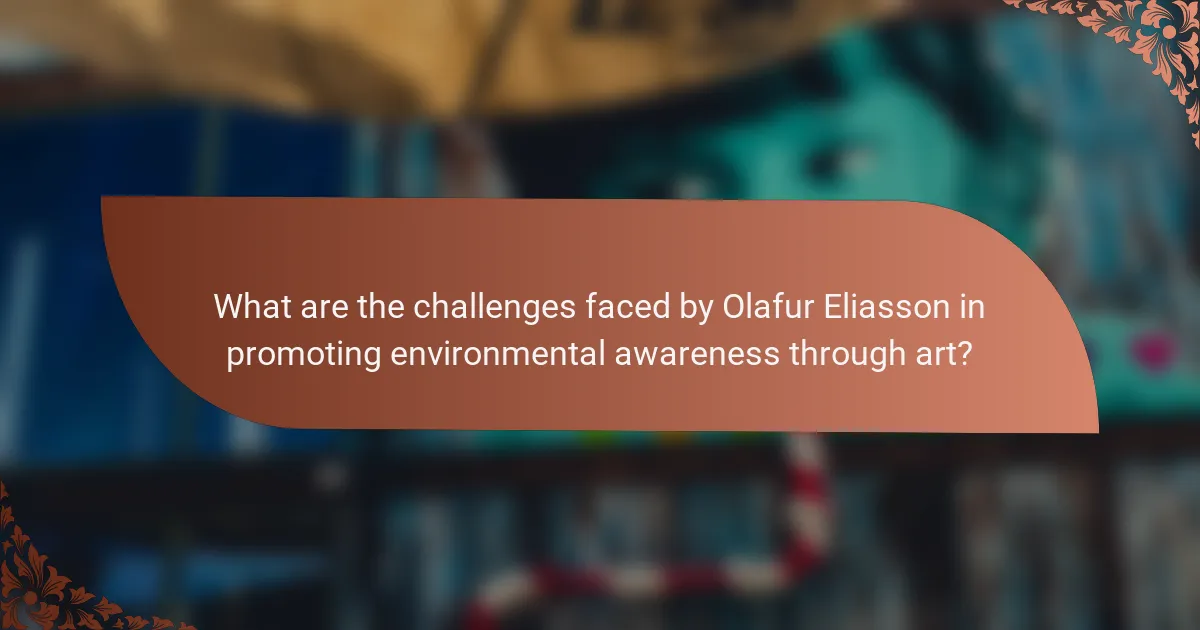
What are the challenges faced by Olafur Eliasson in promoting environmental awareness through art?
Olafur Eliasson faces significant challenges in promoting environmental awareness through art. One major challenge is engaging diverse audiences, as not everyone connects with art in the same way. Additionally, Eliasson must balance artistic expression with scientific accuracy, ensuring that his installations effectively convey environmental messages. Funding and institutional support can also be obstacles, as projects often require substantial resources. Lastly, the transient nature of art installations may limit their long-term impact on awareness and action regarding environmental issues.
How does he address criticism regarding the effectiveness of art in activism?
Olafur Eliasson addresses criticism by emphasizing the transformative power of art in fostering dialogue on environmental issues. He believes art can evoke emotional responses, prompting action and awareness. Eliasson often integrates interactive elements in his installations, allowing audiences to engage personally with environmental themes. This participatory approach enhances understanding and encourages collective responsibility. His work demonstrates that art serves not only as a medium for expression but also as a catalyst for social change.
What obstacles does he encounter in securing funding for large-scale projects?
Olafur Eliasson faces several obstacles in securing funding for large-scale projects. Limited public funding impacts his ability to realize ambitious installations. Additionally, project scope often exceeds budget constraints, making it challenging to attract private investors. Environmental concerns can complicate project approvals, leading to delays. Finally, the intersection of art and environmental awareness may not align with traditional funding sources, limiting options.
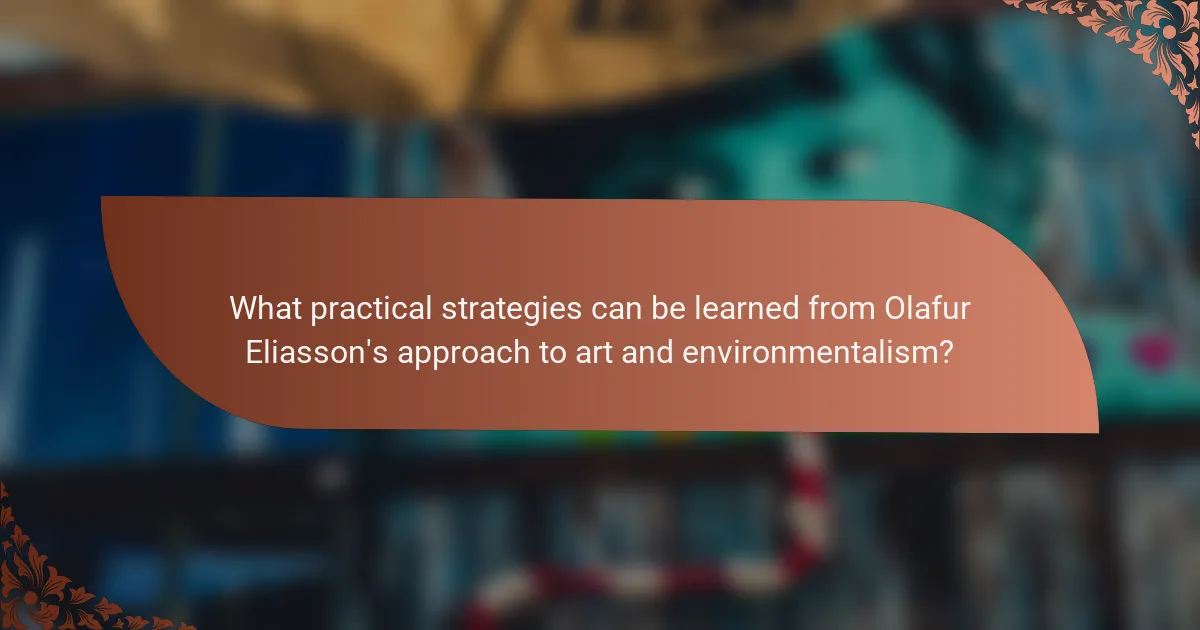
What practical strategies can be learned from Olafur Eliasson’s approach to art and environmentalism?
Olafur Eliasson’s approach to art and environmentalism emphasizes engagement, awareness, and action. He utilizes immersive installations to provoke thought about climate change and human connection to nature.
Eliasson’s work often incorporates natural elements, fostering a direct experience of environmental issues. This method encourages viewers to reflect on their relationship with the environment. His projects, such as “The Weather Project,” create communal experiences that heighten awareness of climate realities.
A practical strategy from Eliasson’s approach is the use of art as a catalyst for dialogue. By creating interactive installations, he invites audiences to participate actively, transforming passive observation into meaningful engagement. This model can inspire artists and activists to use creativity to address environmental challenges effectively.
Another strategy is the integration of sustainability into art production. Eliasson emphasizes eco-friendly materials and processes, demonstrating that art can contribute positively to environmental goals. This approach highlights the potential for artistic practice to align with ecological responsibility.
What best practices can artists adopt to raise awareness on climate issues?
Artists can raise awareness on climate issues by integrating environmental themes into their work, engaging audiences through interactive installations, and collaborating with scientists. Olafur Eliasson exemplifies these practices, using art to provoke dialogue about sustainability. His installations often utilize natural elements, encouraging viewers to reflect on their relationship with the environment. By harnessing social media, artists can amplify their messages and reach wider audiences, fostering community involvement in climate action. Engaging local communities through workshops and collaborative projects can also deepen the impact of their work.
How can communities engage with art to foster environmental stewardship?
Communities can engage with art to foster environmental stewardship by collaborating with artists like Olafur Eliasson. His installations often highlight climate change and nature’s beauty, prompting public dialogue. For example, Eliasson’s “The Weather Project” created awareness about the atmosphere’s fragility. Such art encourages community reflection and action on environmental issues. Engaging with art can transform perceptions, making environmental stewardship a shared priority.
